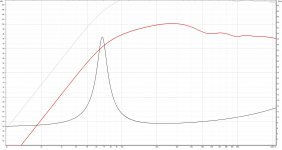Greetings to you all!
I have a query pertaining to an open baffle design using wide band drivers. Below is the simulated plot of a 15" driver on a baffle 36" x 40".

Using the single 15" driver it needs a 6 dB boost centred at 62 hz if I must have a -6 dB response down to 55 hz.
I intend to eliminate the equalisation stage, and for that the logical solution which comes to mind is to add a second identical driver below, wired parallel and low-pass filtered around 85 hz. However, i do not wish to drive it through an inductor, (for it might introduce a phase retard of 45°, as I gather from different material on the internet). To me, it does not appear to be wise to break the integrity of the two 15" drivers working in unison. Besides, the manufacturer data not being reliable enough, I am not certain about the actual impedance at 85 hz - so calculating the required inductance appears to be a gamble.
The lower driver will have its centre 11" above the floor.
* To allow both driver's to work electrically as one, and yet effect an acoustic low-pass filter on the lower driver around 85 hz, I am considering the use of a mechanical muffler - 16 layers of 1" thick open cell foam with a cross section of 18" x18" in front of the lower driver and behind it as well.
[Since i don't have a wife, i can be bold enough not to bother about WAF!! For me, function prevails over form. 😉]
My little understanding tells me that the total gain in response below 85 hz would be +6 dB; i.e. +3 dB from the additional driver and +3 dB from the closeness to the floor. It will yield a response -6 dB down to 50 hz without any equalisation whatsoever.
▪Questions:
1. Do you think it is practically wise to implement such an acoustic low-pass filter? Has such been used by anybody with the intended results?
2. What would be the order or rate of attenuation of such a filter? Would 85 hz be a good filter frequency point for the desired results?
I am confident of many of you having something useful to contribute. I would be grateful for your kind guidance on these naive questions of mine.
Thanks a lot in advance. 😊🙏
Regards,
sujat
I have a query pertaining to an open baffle design using wide band drivers. Below is the simulated plot of a 15" driver on a baffle 36" x 40".
Using the single 15" driver it needs a 6 dB boost centred at 62 hz if I must have a -6 dB response down to 55 hz.
I intend to eliminate the equalisation stage, and for that the logical solution which comes to mind is to add a second identical driver below, wired parallel and low-pass filtered around 85 hz. However, i do not wish to drive it through an inductor, (for it might introduce a phase retard of 45°, as I gather from different material on the internet). To me, it does not appear to be wise to break the integrity of the two 15" drivers working in unison. Besides, the manufacturer data not being reliable enough, I am not certain about the actual impedance at 85 hz - so calculating the required inductance appears to be a gamble.
The lower driver will have its centre 11" above the floor.
* To allow both driver's to work electrically as one, and yet effect an acoustic low-pass filter on the lower driver around 85 hz, I am considering the use of a mechanical muffler - 16 layers of 1" thick open cell foam with a cross section of 18" x18" in front of the lower driver and behind it as well.
[Since i don't have a wife, i can be bold enough not to bother about WAF!! For me, function prevails over form. 😉]
My little understanding tells me that the total gain in response below 85 hz would be +6 dB; i.e. +3 dB from the additional driver and +3 dB from the closeness to the floor. It will yield a response -6 dB down to 50 hz without any equalisation whatsoever.
▪Questions:
1. Do you think it is practically wise to implement such an acoustic low-pass filter? Has such been used by anybody with the intended results?
2. What would be the order or rate of attenuation of such a filter? Would 85 hz be a good filter frequency point for the desired results?
I am confident of many of you having something useful to contribute. I would be grateful for your kind guidance on these naive questions of mine.
Thanks a lot in advance. 😊🙏
Regards,
sujat
